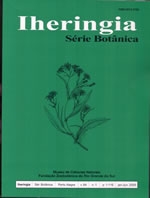Fruit anatomy of Schlechtendalia luzulifolia Less. (Barnadesioideae, Asteraceae Bercht. & J. Presl).
Keywords:
Asteraceae, embryo, endothelium, fruit, seed-coatAbstract
The subfamily Barnadesioideae considered basal in Asteraceae, has great importance for understanding the phylogeny and morphological evolution in the group. The aim of the study is to present a structural description of the pericarp and seed in Schlechtendalia luzulifolia, monotypic genus of Barnadesioideae. The fruits of S. luzulifolia is a cipsela with papyraceous and densely-hairy pericarp, containing one exalbuminous seed. The mesocarp is composed only by parenchymatous cells which form intercellular spaces, where cellular breakdown and collapse events occur in various degrees. The endocarp consists of a single and discontinuous cell layer. A vascular collateral bundle occurs from the raphe up to the anti-raphe, ending near the micropyle. The embryo is axial, continuous, espatulate type, with a short hypocotyl-radicule axis and a crass-like cotyledon which are plane-convex and longer than wide. The morphological characters observed can be considered plesiomorphic to Asteraceae.
Downloads
References
AUGUSTO, Irmão. 1948. Flora do Rio Grande do Sul – Brasil. Porto Alegre: Imprensa Oficial de Porto Alegre. 648p.
Cabrera , a.l. 1974. Compositae. In: BURKART, A. Ed. Flora Ilustrada de Entre Rios (Argentina). Buenos Aires: INTA. t. 6, pt. 6, p. 106-538. (Colección Científica del INTA)
CORNER, E.J.H. 1976. The seeds of dycotiledons. Cambridge: Cambridge University Press. v. 1. 552p.
Feder , n.; o’brien , t.p. 1968. Plant microtechnique: some principles and new methods. American Journal of Botany, v. 55, p. 123-142.
FIOR, C.S.; CARNEIRO, A.M.; BUSNELLO, A.C.; LEONHARDT, C. 2007. Schlechtendalia luzulifolia Less.: estudos de propagação e localização de populações. Revista rasileira de Biociências, v. 5, p. 771-773.
Heineck, O. 1890. Beitrag zur Kenntnis des Feineren Baues der Fruchtschale der Kompositen. Leipzig: Druck C.G. Naumann. 29p.
JANSEN, R.K.; PALMER, J.D. 1987. A chloroplast DNA inversion marks an ancient evolutionary split in the sunflower family (Asteraceae). Proceedings of the National Academy of Sciences, v. 84, p. 5818-5822.
Johri, B.M.; Ambegaokar , K.B.; Srivastava , P.S. 1992. Comparative Embryology of Angiosperms. Berlin: Springer-Verlag. 1221p.
Judd, S.w.; Campbell , c.s.; kellog , e.a.; stevens , p.f.; donoghue , m.j. 2009. Sistemática Vegetal: Um enfoque filogenético. Porto Alegre: Artmed. 632p.
Kim , K.J.; Jansen , R.K. 1995. NdhF sequence evolution and the major clades in the sunflower family. Proceedings of the National Academy of Sciences, v. 92, p. 10379-10383.
McDowell , E.M.; Trump, B. 1976 . Histological fixatives for diagnostic light and electron microscopy. Archives of Pathology & Laboratory Medicine, v. 100, p. 405-414.
MONDIN, C.A.; BAPTISTA, L.R.M. 1996. Relações Biogeográficas
da tribo Mutisieae Cass. (Asteraceae), sensu Cabrera, no Rio Grande o Sul. Comunicação do Museu de Ciências e Tecnologia – PUCRS, Série Botânica, v. 2, n. 1, p. 49-152.
PANDEY, A.K.; SINGH, R.P. 1980. Development and structure of seeds and fruits in tribe Vernonieae – some Vernonia and Elephantopus species. Flora, v. 169, p. 443-452.
PANDEY, A.K.; SINGH, R.P.; CHOPRA, S. 1978. Development and structure of seeds and fruits in Compositae – Cichorieae. hytomorphology, v. 28, p. 198-206.
RIO GRANDE DO SUL. Secretaria Estadual do Meio Ambiente. Lista das espécies da flora ameaçadas de extinção do Rio Grande do Sul, 2002. Disponível em: <http://www.sema.rs.gov.br/sema/html/pdf/especies-ameacadas.pdf>. Acesso em: 27 out. 2008.
Roth, i. 1977. Fruits of Angiosperms. Berlin: Gebrüder Borntraeger. 675p.
Urtubey , e.; teller ía, m.a. 1998. Pollen morphology of the subfamily Barnadesioideae (Asteraceae) and its phylogenetic and taxonomic significance. Review of Paleobotany and Palynology, v. 104, p. 19-37.
Wodehouse , r.p. 1935. Pollen grains. New York: McGraw-Hill. 574p.







